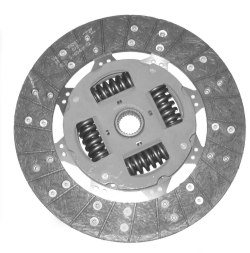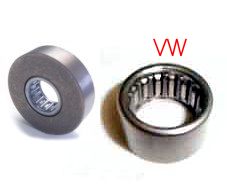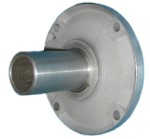(pictures are not all from a VW)
 |
Flywheel The condition of the friction surface of the flywheel is important for proper clutch function. The surface should be smooth and free of burned spots and surface cracks. Used flywheels can be re-surfaced. This should be done by grinding rather than lathe turning as less material is removed. The amount of material removed from the face can affect which clutch release bearing should be used. A flywheel should always be checked for runout on the engine it will be used on. Face runout should not exceed .005 (five thousandths) of an inch. |
 |
Pressure Plate There are basically two types of friction material used for clutch lining. These are organic and metallic. The organic is best for all around use. The metallic is preferred by some for severe duty applications but requires high spring pressures and is hard on the flywheel and pressure plate friction surfaces. Avoid solid hub clutches and clutches without marcel as they will always chatter when used in vehicles with a rear differential mounted on springs (as opposed to a transaxle design). |
 |
Clutch Disc There are basically two types of friction material used for clutch lining. These are organic and metallic. The organic is best for all around use. The metallic is preferred by some for severe duty applications but requires high spring pressures and is hard on the flywheel and pressure plate friction surfaces. Avoid solid hub clutches and clutches without marcel as they will always chatter when used in vehicles with a rear differential mounted on springs (as opposed to a transaxle design). |
 |
Pilot Bushing
(roller bearing as like like to call this one) In most cases, this is a porous bronze, pre-lubed bushing rather than an actual bearing, as it is often called. A few applications still use an actual bearing and others use a needle roller type bearing, but by far, the most common type is bronze. You cannot use a roller bearing on a transmission shaft originally designed for a bronze bushing due to different type of heat treatment on the shafts. The pilot bushing is seldom thought of as a part of the clutch system but it is one of the most vital parts of the system. It pilots the end of the transmission input gear in the crankshaft. If it is worn or not running "true", it can cause serious clutch problems or transmission failure. Pilot bushing bore runout should always be checked with a dial indicator and should be within .002 total. The bronze bushing type should be a press fit in the crankshaft bore. It must be installed carefully. It should have between .001 and .003 clearance on the transmission shaft when installed. The pilot bushing is only functional when the clutch is disengaged but it is a factor in input gear alignment at ALL times. |
 |
Clutch Release Bearing
(sometime called the Throw-out bearing) As its name implies, this is the bearing that releases the clutch. It is often referred toas a "throw-out" bearing. They come on a number of different style carriers. The carriers, in some cases, vary considerably with the particular engine.Because the release bearing only works when the clutch is being released it usually lasts quite a long time. However, improper linkage adjustment or riding the clutch with your foot when driving can wear the bearing prematurely. Normally there should be a minimum of 1/16" clearance between the face of the bearing and the three release fingers or diaphragm spring of the pressure plate when the clutch is engaged. This fact is important and will be discussed further when we get to the part about setting up the clutch linkage. |
 |
Transmission Front Bearing
Retainer This great device has three critical functions. This first is as its name implies. The second is to provide a register on which the bellhousing must center. This is feature is sometimes overlooked with expensive consequences. Thirdly, its tubular snout is the surface on which the throwout bearing rides on its way into to depress the springs of the pressure plate. Conversions often require special and modified retainers to acheive compatibility. |
 |
A """general""" view of a clutch assembly..... |